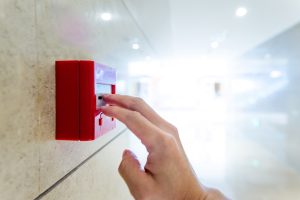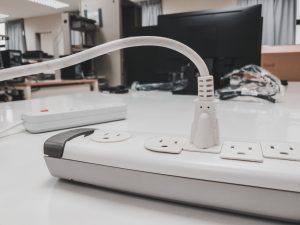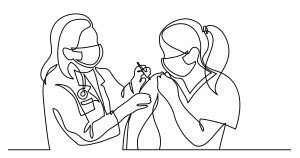January 2022
Inside This Issue
 Happy New Year to our readers! We hope you were able to enjoy a respite from work and also avoided Covid during the holidays. Throughout last year, and again in November and December, we had reviewed new standards taking effect January 1st for water management, workplace violence, resuscitation, performance improvement, and accreditation participation requirements. Hopefully our readers are ahead of the curve and have launched these new standards prior to the beginning of the year.
Happy New Year to our readers! We hope you were able to enjoy a respite from work and also avoided Covid during the holidays. Throughout last year, and again in November and December, we had reviewed new standards taking effect January 1st for water management, workplace violence, resuscitation, performance improvement, and accreditation participation requirements. Hopefully our readers are ahead of the curve and have launched these new standards prior to the beginning of the year.
New Standards for July 2022:
We noted in the January Perspectives that it all begins again, with new several new hospital standards scheduled for implementation in July 2022 in the environment of care, emergency management, and patient rights chapters. Joint Commission publishes this new content providing organizations a 6-month lead time to prepare for new requirements.
The changes in EC and RI are relatively modest, however the EM chapter has gone through a much more significant rewrite. There is also a change in the EC chapter for inpatient hospice providers, bringing the limitations on power strips that hospitals have been struggling with to inpatient hospice.
Our advice is to go to the TJC prepublication page now, download the standards changes, and assign them to your chapter leaders or department heads as appropriate for analysis and implementation planning. These will stay posted to the prepublication page until June 30, 2022. Policy development and training is time consuming so the sooner you can start, the better.
In addition, the changes to the EM chapter are substantial and your emergency operations plan (EOP) is going to need revision, as will your staff training about the EOP.
There is also a new R3 report for Emergency Management that may be a useful reference. It is analyzed at the standard level, not the EP level detail, but it does provide insight on the rationale behind each standard, and perhaps more importantly references and links to resources about each of the new requirements.
Patient’s Rights Standards Changes:
These changes are applicable to the hospital, critical access hospital, ambulatory, behavioral, home care, and nursing care center programs. Previously, Joint Commission had a requirement at RI.01.03.01, EP 3 that established a requirement to obtain consent before any images or video were recorded.
That EP has been deleted, but in its place TJC has created a new EP at RI.01.01.01, EP 37 that requires the organization to “consider patients’ privacy and comply with law and regulation when making and using recordings, films or other images of patients.”
In the past there was guidance from TJC, but now you may have to search for national or state laws relative to video, films, and image production and use.
There is also a second change at RI.01.01.01, EP 1 that defers to law and regulation for consent discussion relative to patient care. TJC is adding another bullet point to the EP stating that the consent discussion should be done by “the licensed practitioner permitted to conduct discussion in accordance with law and regulation.”
This remains the understanding most have held in the past, but again, you may want to consult with your attorney to determine if any edits to your consent policy are necessary.
Environment of Care Standards Changes: 
These changes are applicable to the hospital, critical access hospital, ambulatory, assisted living, behavioral, home care, nursing care centers, and office-based surgery programs.
The first change is in EC.02.03.03, EP 1 and it adds clarity to the existing requirement. Previously the EP had said you could use alternative methods to notify staff of a fire drill between 9 PM and 6 AM. The revised EP now states you can use a “coded announcement” to notify staff during those same hours and they provide a very specific reference to the NFPA requirement.
Another change is to EP 3 of the same standard and it also adds clarity to an issue we have seen develop into a frequently scored issue without significant warning, then later formal identification in the EC/LS Document Review Tool, and now it will be formally published as a transparent requirement in the EP itself.
Previously the EP required fire drills to be held at “unexpected times and under varying conditions.” However, surveyors were clearly looking for at least one hour separation, not just randomness. The new content is a Note 2 stating: “Fire drills vary by at least one hour for each shift from quarter to quarter, through four consecutive quarters.” This is a welcomed change to make this issue clearer.
There is also a new element of performance #7 at EC.02.03.03 which also adds clarity to fire drill requirements for operating rooms. Surveyors have been asking about OR fire drills for some time and now there will be a specific EP that details the requirement.
The new EP requires hospitals using aerosol germicides, antiseptics, or flammable liquids in conjunction with electrosurgery, cautery or lasers, or other ignition sources to perform an annual fire drill in the anesthetizing location. They also state that this drill can be announced or unannounced, but it should focus on the extinguishment of the patient, drapery, clothing, and equipment.
There are two important notes to this new EP. Note 1 states: “The drill involves applicable staff and LIPs and focuses on prevention as well as extinguishment and evacuation.” Note 2 states that this drill if announced cannot be used to meet one of the unannounced quarterly fire drills required by NFPA. Again, this is a welcomed change to add transparency to an issue that is already being scored.
EP 8 in this same standard is also new and it deals with hyperbaric facilities, requiring at least one fire drill per year. There are specific evaluation points in the new Note 1 that state: “The drill includes recording the time to evacuate all persons from the area, involves applicable staff and LIPs, and focuses on prevention as well as simulated extinguishment and evacuation. Response procedures for fires within and outside the hyperbaric chamber address the role of the inside observer, the chamber operator, medical personnel and other personnel as applicable.” Note 2 then states: “If the hospital conducts the drill unannounced, it may serve as one of the required drills.”
EC.02.03.05 has several changes relative to fire safety devices, the first of which is at EP 1 and it too helps to add clarity. EP 1 already requires a test of supervisory signal devices, and the new EP now explains what these are through the addition of a new note. Note 2 states: “Supervisory signal devices include pressure supervisory indicating devices (including both high and low air pressure switches), water level supervisory indicating devices, room temperature supervisory indicating devices, valve supervisory switches, and other supervisory initiating devices.”
EPs 7 and 8 of EC.02.03.05 relative to water storage tanks for fire systems have both been deleted because these are seen so infrequently today.
EP 11 has been modified to add new detail to the fire pump test. Previously the requirement was to test the fire pump under flow every 12 months. The revised EP now states that you should test the fire pump under flow and also states that the fire pump supervisory signals for pump running, and pump power loss are tested annually.
EP 14 has new details on how to test fire extinguishing systems. The EP now details that “carbon dioxide systems be tested every 12 months, halon systems every 6 months and other special systems per NFPA and the manufacturers recommendations.”
EC.02.04.01 has been updated to bring back a requirement previously seen as EP 8 back in 2016, but was inadvertently dropped, requiring the hospital to monitor and report all incidents in which medical equipment is suspected in or attributed to the death, serious injury, or serious illness of any individual, as required by the Safe Medical Devices Act of 1990.
The last EC change is in EC.02.05.01, EP 27 which discusses requirements for operating room smoke control systems, but not the smoke generated by human tissue in contact with cauterizing equipment. The revised EP provides a reference to the testing requirements of NFPA 92-2012 for newly engineered, designed and installed systems, unless specifically exempted by the authority having jurisdiction.
Additionally, it states that existing systems not meeting the performance requirements of the testing specified in NFPA 101-2012:19.7.7.1 can be continued in operation only with the specific approval of the authority having jurisdiction.
You will want to send all of these EC changes to your facilities leadership for review and analysis as they will likely require policy development and modifications to existing fire safety and equipment safety plans and inspection or testing checklists.
The changes to the 40-page Emergency Management chapter are much more substantial but the bulk of the changes are on pages 23-40 only. We will discuss this chapter in next month’s newsletter. In the meantime, we suggest you do download the chapter and provide it to your Emergency Management leader to start their review.
New Requirements for Inpatient Hospice:
Inpatient hospice facilities have three new requirements. The first of which is EC.02.05.01, EP 23 dealing with power strips or as they are formally known – relocatable power taps (RPTs). Hospitals have been struggling with this re quirement for several years as it requires any power strips in the patient care vicinity to be approved by Underwriters Laboratory, specifically either UL 1363A or UL 60601-1.
quirement for several years as it requires any power strips in the patient care vicinity to be approved by Underwriters Laboratory, specifically either UL 1363A or UL 60601-1.
Power strips outside of the patient care vicinity but still within the room must be UL1363. In non-patient care rooms or areas any power strips must meet other UL standards. Note 2 of this EP helps to define patient care vicinity at 6 feet from the bed or chair or treatment table.
The second inpatient hospice change is in EC.02.05.07, EP 8 and this requires at least an annual test of the fuel quality for the emergency generator. The test required is to ASTM standards (American Society for Testing Materials). We have seen many omissions of this requirement in hospital organizations; the key is to get this on the schedule for the organization every year.
The third inpatient hospice change is a generic, catch-all standard to “keep furnishings and equipment safe and in good repair.” Generic standards such as this are often used to cite dirty, old equipment, devices or furnishings that look to be in disrepair.
Hand Hygiene Scoring: 
The Consistent Interpretation column continues to shed new light on the nuances of scoring. This month’s focus in on hand hygiene and as usual there are several revelations.
Under the discussion for IC.01.02.01, EP 3 one surveyor finding mentions that the manufacturer’s instructions for use of their alcohol-based hand rub (ABHR) required the first use of the day to include use of a nail pic. As consultants, this was new information to us as we do not know which brand of ABHR that might be, nor have we seen TJC score this issue.
However, if any of our readers use a brand where the package insert states that staff must use a nail pic, we would like to know what the brand is, so that our readers can find an alternative if they use that same brand. We noted on the right side of the column were SIG weighs in, they state: “Score at IC.02.01.01, EP 2, if nail picks are available, but not used.” Our search for internet details about this turned up empty.
The guidance for IC.02.01.01 is similarly interesting, busting two myths relative to hand hygiene. SIG guidance states that evaluation of hand hygiene for patient care involving C diff patients should depend on hospital policy as there is no clear guidance that alcohol or soap and water is clearly superior.
They also provide guidance that removing jewelry prior to hand hygiene is a CDC level II recommendation and therefore not required by TJC. They also warn that some manufacturer’s instructions for use may have more detailed guidance relative to jewelry.
ITHS Findings:
This month’s EC News has a detailed article on a subject all of our readers would like to avoid and that is a TJC Immediate Threat to Health and Safety situation (ITHS). The article does focus on environmental causes of the ITHS, and there are additional potential routes to this decision due to clinical concerns.
This result is comparable to the CMS survey outcome they call immediate jeopardy (IJ). This survey decision can occur when the surveyors observe a situation that is so egregious that they perceive patients and/or staff are at risk of serious harm due to that situation. TJC lists potential environmental situations that could result in the ITHS including:
- Significantly compromised fire alarm system
- Significantly compromised emergency power system
- Significantly compromised medical gas system
- Significant ligature risks in a behavioral health environment
- Significant infection prevention and control issues
- Significantly compromised sprinkler system
- Significantly compromised exits
- Significant lapses in maintaining high risk utilities and medical equipment
They then describe in greater detail some examples explaining what specifically might lead to such an outcome in each of the above scenarios. There is also a flow chart that depicts the implementation of the decision and resultant actions that need to be taken by the organization, such as immediate mitigation or abatement of the high-risk issue. The flow chart also describes the actions taken on the TJC side, which include a preliminary denial of accreditation decision.
Bottom line, these are all situations you will want to avoid. Unfortunately, these situations do occur with greater frequency than you would like to think and fixing an inoperable fire alarm, emergency power system, medical gas, or sprinkler system is not easy, quick, or inexpensive.
As consultants we do sometime see organizations struggling with such issues, hoping that when the Joint Commission comes, they may not notice the issue. This is a losing strategy however as the scrutiny the life safety code surveyors apply to each of these focus areas is so thorough that there is no chance these major issues would ever be missed. If such a situation should ever occur in your organization, it can’t wait until next year’s budget cycle or the new building under construction to open; it needs to be fixed now.
This is a good article to share with your facilities leadership and discuss at an accreditation or environment of care meeting so that everyone understands the urgency of immediate action should one of these issues be internally identified at your organization.
Survey Process for Business Occupancies:
EC News this month has an article clarifying the survey process for business occupancies. One point of confusion has been the life safety drawings and if they are required or not required. This article states that if the building being surveyed is entirely a business occupancy, then life safety code drawings would not be required. However, if the building being surveyed is mixed occupancy including business and health care or ambulatory occupancy, then these life safety code drawings would be needed.
You might also be wondering if Joint Commission surveyors would be looking above the ceiling in these business occupancies for penetrations or cables draped on sprinkler pipes. The guidance from EC News on this issue is that generally surveyors will not be looking above the ceiling. However, they state that in a mixed-use building with business and health care or ambulatory occupancies, they state that TJC would inspect the fire barrier between those spaces, on both sides.
TJC also advises that if the accredited space is on the first floor of a multistory building, the surveyors would not be “surveying the stairway going to upper floors, but they would be looking for combustible storage in the stairway.” This sounds ambiguous to us as the difference between “not surveying” and “just taking a look for combustibles” seems too hazy. The situation where the accredited space is on an upper floor is stated more clearly as TJC indicates in this case, they would survey the stairway as well as the path of exit from the building.
Validation Survey Process: 
CMS issued two additional memos in the past month of significance to our industry. The first is QSO 22-16, issued on December 15, 2021. This is the annual report to Congress on the validation survey process between CMS and accrediting organizations. As has been the case for many years there is a significant disparity rate between the COP level findings between CMS and accreditors.
Our typical recommendation is to be aware that the accreditors scoring may become harsher, but we have not seen that as the result.
Vaccine Mandate: 
The second CMS memo is QSO 22-07, dated December 28, 2021. In this memo CMS modified its suspension of enforcement for the vaccine mandate described in QSO 22-04 dated December 1, 2021. In the latest memo CMS now states it will enforce the mandate in 25 states not covered by court orders and continue to not survey in the other 25 states that are currently on hold due to court orders.
In addition, as you all probably heard, the OSHA and CMS vaccine mandates did go before the US Supreme Court on January 7th, and the nation is anticipating a decision from the court soon.
Consultant Corner
Dear Readers,
We hope everyone had a Happy Holiday season and Happy New Year!
Do you want your staff educated on the new standards changes and top scored findings? Reach out for our customized education from our experts! We can do focused education on sterile compounding, sterile processing, survey readiness, and more!
Jennifer Cowel, RN MHSA
JenCowel@PattonHC.com
Kurt Patton, MS RPh
Kurt@PattonHC.com
John Rosing, MHA
JohnRosing@PattonHC.com
Mary Cesare-Murphy, PhD
MCM@PattonHC.com
